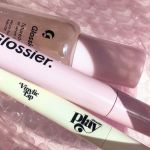
Why is Glossier on a rollercoaster?

March 15th, 2022
Going back to 2014, when beauty blogger Emily Weiss' story became one of the first to represent the bossbabe ideal as we know it today, there was nothing but talk about Glossier and its innovative textures. Glossier was one of the first brands to enjoy the boost of a photo-sharing platform, when the difference between business and creator accounts didn't yet exist and when the algorithm wasn't as precise as it is today, and it left its mark with its elevated pastel-toned aesthetic, echoing design and cross-sector experiences, accompanying hybrid formulations between makeup and skincare. It is still definitely successful today, remaining in the history of the most replicated beauty start-ups ever, but due to a brand loyalty with a clientele that grows yes with the brand but doesn't adapt to the market trends increasingly closer to Gen Z, its current condition is living on a roller coaster, between opening pop-up stores in central London and the recent layoff of 1/3 of its employees. Why is this happening?
Glossier achieved the status it enjoys today thanks to its direct-to-consumer sales strategy, which differentiated the Helvetica name from the big beauty corporations, proving almost 10 years ago that it was possible to reach 1.8 million annual sales without the need for intermediaries such as department stores or retailers like Sephora. An example for hundreds of start-ups in the beauty field that have emulated the feat, it's Glossier's strategy that is causing the brand to falter now: after the first year of the pandemic, sales fell by 26% according to Bloomberg Second Measure, in 2021 the brand's most glittery and glamorous newborn section, Glossier Play, was closed after just one year from launch, and in the recent January 26, 2022, the choice of laying off 80 members of its workforce was defended by the Founder and CEO via never to BoF as a move to safeguard the brand and prioritize some, precisely, strategic projects.
The driving reason behind these strategic indecisions could be hidden behind an aging of the brand values in the eyes of the most relevant consumers of the moment, Gen Z. Born from the online magazine Into The Gloss, Glossier represents beauty, business and aspirational ideals that have inspired a target between 25 and 35 years old in a profound way, transforming customers into brand lovers. The passion for natural beauty and the proximity to a less structured concept of make-up, comparable to "clean beauty" are still relevant today, but the pastel and hyper-feminine aesthetics consistently advertised over the years may have aged along with the target audience. In fact, Glossier's new products include anti-aging agents such as retinol, natural formulations but maintain the font and pastel pink that are not usually appreciated by the most avid consumers of the moment, those of Gen Z, who are fond of more linear graphic elements and close to minimal design, pop colors and hi-tech formulations. Having a strong identity and being true to the needs and preferences of your audience is a key concept in marketing, but also adapting to market trends and looking ahead, especially to compete with brands currently strong in Gen Z such as The Ordinary, Cerave and Youth to The People.
The right path, perhaps uphill, for the brand is definitely to overhaul its graphic identity, certainly not to create a secondary line, precisely already failed. Adopting a different shade of pastel pink making it more shocking, such as Valentino PP Pink or Jacquemus pink, or a strong pattern that distinguishes Glossier to the naked eye and the right communication could captivate new consumers even on Tik Tok thanks to the renowned quality, which after all has 8 years of history. Effective positioning in the "clean beauty" sector and in the philosophy of glowy and less is more is valuable for the brand, which could explore new possibilities in the lab by piquing the curiosity of the following that it has nurtured with creams and multi-purpose products for years by developing new hybrid formulations, proving to be a brand in step with the times that doesn't barter its identity.




























































